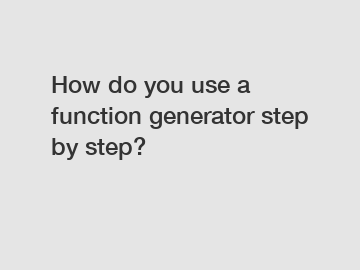Feb. 05, 2024
Measurement Instruments
How do you use a function generator step by step?
A function generator is a versatile piece of equipment in the field of electronics. It is used to generate different types of electrical waveforms, such as sine, square, triangle, and sawtooth waves. In this article, we will discuss how to use a function generator step by step.
Step 1: Connect the function generator to the power source.

Before using the function generator, it is essential to connect it to a power source. Most function generators have an AC power input, so you will need to ensure that it is correctly plugged into a power outlet.
Step 2: Turn on the function generator.
Once connected to the power source, you can proceed to turn on the function generator. Typically, function generators have a power switch located either on the front panel or the backside. Flip the switch to the ON position, and the device will start powering up.
Step 3: Set the frequency.
The primary function of a function generator is to generate different frequencies. To set the desired frequency, locate the frequency control knob on the front panel. You can rotate the knob clockwise or counterclockwise to adjust the frequency value. Many function generators also allow you to enter the frequency using numeric buttons.
Step 4: Select the waveform type.
Further reading:After setting the frequency, you will need to select the waveform type you want to generate. Function generators have a waveform selector knob that allows you to choose between sine, square, triangle, sawtooth, and other custom waveforms. Rotate the knob until the desired waveform is selected.
Step 5: Adjust amplitude and offset.
The amplitude and offset control the voltage level and DC offset of the generated waveform, respectively. Most function generators have separate knobs for adjusting these parameters. By turning the knobs, you can increase or decrease the amplitude and set a desired DC offset if necessary.
Step 6: Connect the output.
Once you have set all the parameters, it is time to connect the function generator's output to the circuit or device you want to test or stimulate. Function generators usually have an output terminal where you can connect a BNC cable or other suitable connectors based on your requirements.
Step 7: Start generating the waveform.
After connecting the output, double-check that all the settings are correct, and then press the "Generate" or "Start" button on the function generator. The device will start generating the selected waveform with the desired frequency, amplitude, and offset.
Using a function generator allows electronics engineers, researchers, and hobbyists to test circuits, simulate real-world signals, and troubleshoot electronic systems. By controlling the frequency, waveform type, and other parameters, they can analyze the behavior of a circuit under different conditions.
In conclusion, using a function generator is a straightforward process that involves connecting the device to a power source, setting the frequency, selecting the waveform type, adjusting the amplitude and offset, connecting the output, and starting the waveform generation. Understanding how to use a function generator is essential for anyone working in the field of electronics, as it enables precise control and analysis of electrical signals.
Contact us to discuss your requirements of Frequency Counter Application, Budget Spectrum Analyzer, Low Cost Spectrum Analyser. Our experienced sales team can help you identify the options that best suit your needs.
Further reading:Related Articles
If you are interested in sending in a Guest Blogger Submission,welcome to write for us!
All Comments ( 0 )